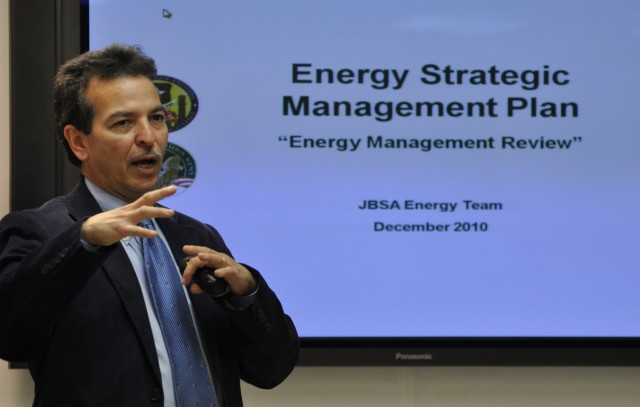JOINT BASE SAN ANTONIO -- Experts from the Department of Defense, Air Education Training Command and Joint Base San Antonio kicked off an energy conservation summit at Fort Sam Houston Dec. 7 to construct a Strategic Energy Management Plan for Fort Sam Houston and Lackland and Randolph Air Force Bases.
The summit was followed by three days of working-level sessions where energy and resources efficiency managers exchanged ideas aimed at developing a plan with measurable outcomes.
"We want to lean our processes and figure out what we're doing right and what we're doing wrong," said Col. Robert Bridgford, 502nd Air Base Wing vice commander.
"We spend about $40 million in utilities right now and we've got about $10 million worth of great energy projects, but our metrics are not going in the right direction."
Bridgford presented several guidelines established by Air Force Brig. Gen. Leonard Patrick, 502nd ABW commander, to direct planning during the summit: identify high-usage facilities and processes; remove or replace inefficient systems and processes; establish new standards with new facilities; utilize fresh ideas and establish a culture of conservation that will be a permanent fixture for JBSA.
Bridgford said Patrick is also looking to make the plan a template for the rest of the military.
"We're always looking for best practices and how to export that to the other services and then to the other joint bases," Bridgford said.
JBSA facilities have already worked hard at putting energy and water conservation measures in place, noted Jesse Johnson, deputy director at the Department of Defense Lean Six Sigma program, Office of the Deputy Chief Management Officer.
Johnson said the LSS approach his office uses streamlines efforts at developing a plan with better metrics representing reality, enabling improved resource management, and allowing for funding for future projects.
"The challenge is to connect all the work to the strategic guidance," Johnson explained.
Under then-president George W. Bush, the National Defense Authorization Act for fiscal year 2008 called for a Strategic Management Plan providing an overview of the Department's overall planning and management framework.
A second SMP published in July 2009 included specific details on performance goals and measures, and initiatives underway to achieve them in order to deliver effective and efficient support to the war fighter.
The current administration is using this guidance to facilitate military conservation efforts through the Office of the DCMO using LSS methodology which defines, measures and analyzes processes.
Johnson said there has already been success linking work done at JBSA with national objectives.
"As an example, in May, the National Security Strategy was released and we've already connected work here at JBSA."
He said the goal is to gain visibility for that work and connect the dots so that both local and national offices are on the same page.
"When this is done it will be clear and everyone will be able to follow the same model forward," Johnson said.
Target date for finalizing the SEMP is Jan. 30 with a February-March time frame for JBSA energy requirements submission.


Social Sharing